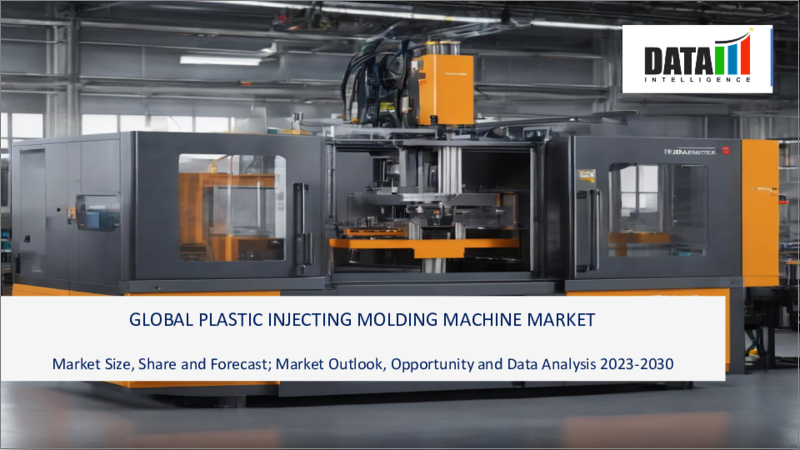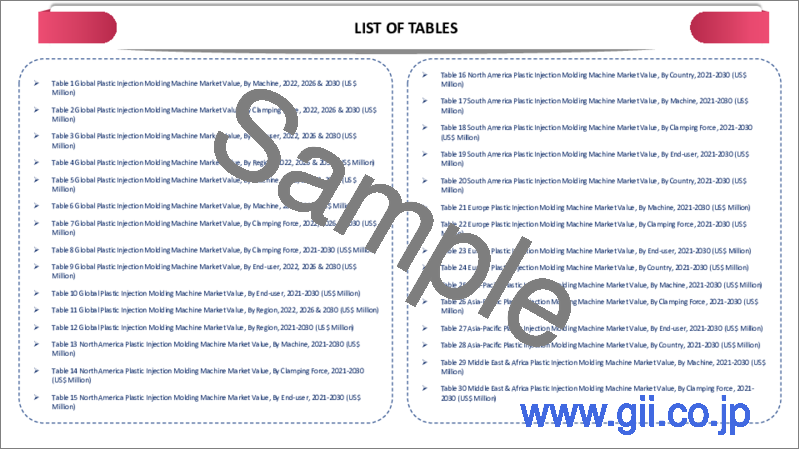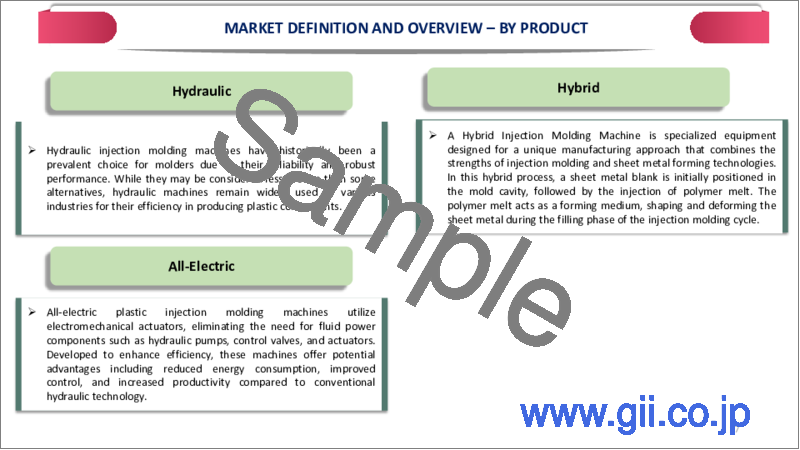|
|
市場調査レポート
商品コード
1304488
プラスチック射出成形機の世界市場-2023年~2030年Global Plastic Injection Molding Machine Market - 2023-2030 |
||||||
カスタマイズ可能
適宜更新あり
|
|||||||
| プラスチック射出成形機の世界市場-2023年~2030年 |
|
出版日: 2023年07月07日
発行: DataM Intelligence
ページ情報: 英文 192 Pages
納期: 即日から翌営業日
|
- 全表示
- 概要
- 目次
市場概要
プラスチック射出成形機の世界市場は、2022年に82億米ドルに達し、2023-2030年の予測期間中にCAGR 4.0%で成長し、2030年には112億米ドルに達すると予測されています。特にアジア太平洋地域におけるeコマース産業の爆発的な成長により、プラスチック成形パッケージの需要が増加します。
プラスチック射出成形機の世界市場は、新しい自動化プロトコルなどの技術進歩により、機械の精度が向上し、生産性が強化され、ダウンタイムが短縮され、ハイテク製造アプリケーションに適するようになり、急速な変化を経験することになります。現在、ロボットによる自動化が進んでいるのは後加工のみです。
さらに、特別に開発されたプラスチック部品を使用する医療用インプラントやデバイスの新たな進歩が、予測期間中の世界のプラスチック射出成形機市場の成長を促進すると予想されています。例えば、スイスのプラスチック加工業者であるSamaplast社は、ステンレス鋼やチタン製のインプラントに代わるものとして、PEEKベースの射出成形骨インプラントを開発しました。
市場力学
包装需要の増加
世界人口の増加、ライフスタイルの変化、可処分所得の増加により、消費財の需要が急増しています。飲食品、パーソナルケア、家庭用品、化粧品など様々な産業が、製品の販売や配送にプラスチック包装を多用しています。プラスチック射出成形機は、メーカーがこれらの業界の特定の要件を満たすカスタマイズされたパッケージングソリューションを製造することを可能にします。
包装は、製品を保護・保存し、棚に並べる魅力を高め、便利な取り扱いを保証する上で極めて重要です。プラスチックパッケージングソリューションは、その汎用性、軽量性、耐久性、費用対効果により人気を博しています。プラスチック射出成形機は、ボトル、キャップ、クロージャー、容器、トレイなど、多くのプラスチック包装部品を製造するために不可欠です。
原材料価格の変動
原材料、特に石油系プラスチックの価格の変動は、プラスチック射出成形の収益性と費用対効果に影響を与える可能性があります。石油系プラスチックは、世界市場における原油価格の変動に直接影響を受けます。樹脂価格の変動は、プラスチック部品の製造コストに直接影響します。
価格変動の長期化は、中小企業の将来の事業拡大や設備投資計画に影響を与える可能性があります。製造業者もまた、原材料価格の変動により、製造コストの見積もりや管理に課題を抱えています。価格変動による設備投資や研究費の減少は、将来の開発やイノベーションに影響を与え、市場の成長を制約する可能性があります。
COVID-19の影響分析
COVID-19の大流行は世界のサプライチェーンに混乱を引き起こし、原材料や機械部品の入手に影響を与えました。パンデミックは消費者の行動や嗜好を変え、特定の製品に対する需要に影響を与えました。例えば、自動車業界は急激な売上減少に見舞われました。しかし、医療業界や包装業界からの需要は比較的堅調に推移しました。
様々な業界で後退が見られたもの、ヘルスケアや医療機器業界では新たなビジネスチャンスが生まれました。パンデミック後は、消費者需要の回復に伴い、製造業からの需要が増加しています。世界のプラスチック射出成形機市場は、各産業が総生産能力での生産を再開し、新たな市場動向に適応するにつれて、パンデミックの影響から勢いを取り戻し、順調に回復すると予想されます。
AIの影響
AI技術は、様々な射出成形工程の改良を可能にし、効率を向上させ、必要な労働力を削減します。機械学習アルゴリズムは、生産パラメーターを最適化し、欠陥を最小限に抑え、設備の有効性を高めることができます。AIはまた、モノの産業インターネット(IIoT)やデータ駆動型意思決定などのスマート製造コンセプトの実装を促進することができます。
プラスチック射出成形機の高度な自動化は、人工知能技術の成熟によって可能になります。エンド・ツー・エンドの自動化が可能になり、生産コストを大幅に下げることができるため、さまざまな産業でプラスチック成形部品の採用が広まると思われます。
ウクライナ・ロシアの影響
ウクライナ・ロシア戦争は、世界のエネルギー市場に変動をもたらしました。ロシアは石油・ガスの主要生産国であったが、米国と欧州連合(EU)から制裁を受け、世界の供給が途絶えたからです。エネルギー供給が途絶えたことで、欧州ではエネルギー主導の激しいインフレが起きました。エネルギー価格の高騰は、欧州の製造業の競争力をも失わせた。ドイツやオーストリアの多くの企業がプラスチック射出成形機を製造しています。
このため、他地域のメーカーがこの状況を利用する機会が生まれています。日本と中国には、プラスチック射出成形機を幅広く開発している企業が数多くあります。中国には、生産コストが大幅に低いというさらなる利点があります。これらの国々は、欧州メーカーの大きなシェアを獲得するのに最も適しています。
目次
第1章 調査手法と調査範囲
第2章 定義と概要
第3章 エグゼクティブサマリー
第4章 市場力学
- 影響要因
- 促進要因
- 新興国における工業化の進展
- 製造技術の進歩
- 包装需要の増加
- 抑制要因
- 高い設備投資
- 原材料価格の変動
- 機会
- 影響分析
- 促進要因
第5章 産業分析
- ポーターのファイブフォース分析
- サプライチェーン分析
- 価格分析
- 規制分析
第6章 COVID-19分析
第7章 機械タイプ別
- 油圧式
- オール電化
- ハイブリッド
第8章 クランプ力別
- 0~200トン
- 200-500トン
- 500トン以上
第9章 エンドユーザー別
- 自動車
- 消費財
- パッケージング
- ヘルスケア
- 電気・電子
- その他
第10章 地域別
- 北米
- 米国
- カナダ
- メキシコ
- 欧州
- ドイツ
- 英国
- フランス
- イタリア
- スペイン
- その他欧州
- 南米
- ブラジル
- アルゼンチン
- その他南米
- アジア太平洋
- 中国
- インド
- 日本
- オーストラリア
- その他アジア太平洋地域
- 中東・アフリカ
第11章 競合情勢
- 競合シナリオ
- 市況/シェア分析
- M&A分析
第12章 企業プロファイル
- Haitian International Holdings Limited
- 会社概要
- 製品ポートフォリオと説明
- 財務概要
- 主な発展
- Sumitomo Heavy Industries, Ltd
- The Japan Steel Works, LTD
- Chen Hsong Holdings Limited
- ENGEL AUSTRIA GmbH
- ARBURG GmbH+Co. KG
- Nissei Plastic Industrial Co. Ltd
- Coperion GmBH
- Husky Technologies
- KraussMaffei Group GmBH
第13章 付録
Market Overview
The Global Plastic Injection Molding Machine Market reached US$ 8.2 billion in 2022 and is expected to reach US$ 11.2 billion by 2030, growing with a CAGR of 4.0% during the forecast period 2023-2030. The explosive growth in the e-commerce industry, especially in Asia-Pacific, will increase demand for plastic molded packaging.
The Global Plastic Injection Molding Machine Market is set to experience rapid changes with technological advancements such as new automation protocols, which have increased machinery precision, enhanced productivity and reduced downtime, making it suitable for high-technology manufacturing applications. Currently, only post-processing has been largely automated by robots.
Furthermore, new advances in medical implants and devices, which make use of specially developed plastic components, is expected to propel the growth of the global plastic injection molding machine market during the forecast period. For instance, Samaplast, a Swiss plastics processor, has developed a PEEK-based injection molded osteo-implant as an alternative to stainless steel and titanium implants.
Market Dynamics
Increasing Demand For Packaging
The rising global population, changing lifestyles, and increased disposable incomes have led to a surge in the demand for consumer goods. Various industries, including food and beverages, personal care, household products, and cosmetics, heavily rely on plastic packaging to market and deliver their products. Plastic injection molding machines enable manufacturers to produce customized packaging solutions that meet the specific requirements of these industries.
Packaging is crucial in protecting and preserving products, enhancing their shelf appeal, and ensuring convenient handling. Plastic packaging solutions have gained popularity due to their versatility, lightweight nature, durability, and cost-effectiveness. Plastic injection molding machines are essential for producing many plastic packaging components, including bottles, caps, closures, containers and trays.
Volatility In Raw Material Prices
Fluctuations in raw material prices, particularly petroleum-based plastics, can impact the profitability and cost-effectiveness of plastic injection molding. Petroleum-based plastics are directly impacted by the volatility of oil prices in the global market. Changes in resin prices directly influence the manufacturing costs of plastic components.
Prolonged price volatility can impact future expansion and capital investment plans of small and medium enterprises. Manufacturers also face challenges in estimating and managing production costs due to the volatility of raw material prices. A decrease in capital expenditure and research spending due to price volatility can impact future developments and innovations, thus constraining market growth.
COVID-19 Impact Analysis
The COVID-19 pandemic caused disruptions in global supply chains, affecting the availability of raw materials and machinery components. The pandemic changed consumer behavior and preferences, impacting the demand for certain products. For instance, the automotive industry experienced a sharp decline in sales. However, demand remained relatively robust from the medical and packaging industries.
Despite setbacks in various industries, new opportunities emerged in the healthcare and medical device industries. The post-pandemic period has witnessed increased demand from manufacturing industries as consumer demand recovers. The global plastic injection molding machine market is expected to regain momentum and recover well from the effects of the pandemic as industries resume production at total capacity and adapt to new market trends.
AI Impact
AI technologies enable the refinement of various injection molding processes, improving efficiency and reducing labor requirements. Machine learning algorithms can optimize production parameters, minimize defects, and enhance equipment effectiveness. AI can also facilitate the implementation of smart manufacturing concepts, such as the Industrial Internet of Things (IIoT) and data-driven decision-making.
A higher degree of automation in plastic injection molding machines can be made possible with the maturing of artificial intelligence technologies. It would be possible to implement end-to-end automation, which could drastically lower production costs, thereby increasing the proliferation in adoption of molded plastic components by various industries.
Ukraine-Russia Impact
The Ukraine-Russia war has created volatility in global energy markets as Russia was a leading oil and gas producer which was sanctioned by the U.S. and the European Union (E.U), thereby disrupting global supplies. The disruption in energy supply has led to heavy energy-driven inflation in Europe. High energy prices have also disrupted the competitiveness of the European manufacturing industry. Many German and Austrian companies manufacture plastic injection molding machines.
It has created opportunities for manufacturers in other regions to capitalize on this situation. Japan and China have numerous companies developing a wide range of plastic injection molding machines. China has a further advantage of significantly lower production costs. These countries are best suited to capture a major share of European manufacturers.
Segment Analysis
The Global Carbon Fiber Prepreg Market is segmented based on machine type, clamping force, end-user and region.
Due To Economic Costs And Simplicity Of Operation, Hydraulic Machines Are the Most Widely Used
Hydraulic plastic injection molding machines use hydraulic systems to generate the necessary force for the injection process. Hydraulic machines offer high clamp force, enabling them to handle large molds and heavy parts. The devices are known for their robustness, durability, and versatility across various applications. Hydraulic machines are typically more cost-effective than all-electric machines, making them attractive for manufacturers with lower initial investment budgets.
Small and medium enterprises, especially those operating in emerging economies such as India, typically prefer hydraulic plastic injection molding machines. A significant chunk of the global demand for molded plastics is expected to come from Asia-Pacific, as the regional expansion of various manufacturing and service industries gathers pace.
Geographical Analysis
Packaging And Automotive Industries Make North America A Major Market Share
North America occupies a share of nearly a quarter of the global plastic injection molding machine market. North America has a well-developed and diverse manufacturing industry, making it a major demand for plastic injection molding machines. The region has various industries, including automotive, electronics, packaging and aerospace. Despite outsourcing manufacturing to Asia-Pacific, North America still retains significant industrial capacity.
The automotive industry in North America is a major consumer of plastic injection molded components. The region is home to several automobile manufacturers, such as Ford Motors, GM and Tesla and suppliers who utilize plastic injection molding for various automotive parts, such as interior components, exterior trims and under-the-hood components.
The packaging industry in North America is one of the largest consumers of plastic injection molded products. Various large, small and medium enterprises are engaged in the manufacturing of plastic packaging for multiple end-users. Plastic packaging solutions are widely used in food and beverage, pharmaceuticals, personal care and other sectors.
Competitive Landscape
The major global players include: Hexcel Corporation, Toray Industries, Inc., SGL Group, Teijin Carbon Europe GmbH, Gurit Holding, Plastic Reinforcement Fabrics Ltd, TEI Composites Corporation, Mitsubishi Chemical Carbon Fiber and Composites, Inc., Axiom Materials, Inc. and Park Electrochemical Corp.
Why Purchase the Report?
- To visualize the Global Plastic Injection Molding Machine Market segmentation based on machine type, clamping force, end-user and region, and understand key commercial assets and players.
- Identify commercial opportunities by analyzing trends and co-development.
- Excel data sheet with numerous data points of plastic injection molding machine market-level with all segments.
- PDF report consists of a comprehensive analysis after exhaustive qualitative interviews and an in-depth study.
- Product mapping available as Excel consisting of key products of all the major players.
The Global Plastic Injection Molding Market Report Would Provide Approximately 57 Tables, 60 Figures And 192 Pages.
Target Audience 2023
- Manufacturers/ Buyers
- Industry Investors/Investment Bankers
- Research Professionals
- Emerging Companies
Table of Contents
1. Methodology and Scope
- 1.1. Research Methodology
- 1.2. Research Objective and Scope of the Report
2. Definition and Overview
3. Executive Summary
- 3.1. Snippet by Machine Type
- 3.2. Snippet by Clamping Force
- 3.3. Snippet by End-User
- 3.4. Snippet by Region
4. Dynamics
- 4.1. Impacting Factors
- 4.1.1. Drivers
- 4.1.1.1. Increasing Industrialization of Emerging Economies
- 4.1.1.2. Advancements in Manufacturing Technologies
- 4.1.1.3. Increasing Demand for Packaging
- 4.1.2. Restraints
- 4.1.2.1. High Capital Investment
- 4.1.2.2. Volatility in Raw Material Prices
- 4.1.3. Opportunity
- 4.1.4. Impact Analysis
- 4.1.1. Drivers
5. Industry Analysis
- 5.1. Porter's Five Force Analysis
- 5.2. Supply Chain Analysis
- 5.3. Pricing Analysis
- 5.4. Regulatory Analysis
6. COVID-19 Analysis
- 6.1. Analysis of COVID-19
- 6.1.1. Scenario Before COVID
- 6.1.2. Scenario During COVID
- 6.1.3. Scenario Post COVID
- 6.2. Pricing Dynamics Amid COVID-19
- 6.3. Demand-Supply Spectrum
- 6.4. Government Initiatives Related to the Market During Pandemic
- 6.5. Manufacturers Strategic Initiatives
- 6.6. Conclusion
7. By Machine Type
- 7.1. Introduction
- 7.1.1. Market Size Analysis and Y-o-Y Growth Analysis (%), By Machine Type
- 7.1.2. Market Attractiveness Index, By Machine Type
- 7.2. Hydraulic*
- 7.2.1. Introduction
- 7.2.2. Market Size Analysis and Y-o-Y Growth Analysis (%)
- 7.3. All-Electric
- 7.4. Hybrid
8. By Clamping Force
- 8.1. Introduction
- 8.1.1. Market Size Analysis and Y-o-Y Growth Analysis (%), By Clamping Force
- 8.1.2. Market Attractiveness Index, By Clamping Force
- 8.2. 0-200 Tons Force*
- 8.2.1. Introduction
- 8.2.2. Market Size Analysis and Y-o-Y Growth Analysis (%)
- 8.3. 200-500 Tons Force
- 8.4. Above 500 Tons Force
9. By End-User
- 9.1. Introduction
- 9.1.1. Market Size Analysis and Y-o-Y Growth Analysis (%), By End-User
- 9.1.2. Market Attractiveness Index, By End-User
- 9.2. Automotive*
- 9.2.1. Introduction
- 9.2.2. Market Size Analysis and Y-o-Y Growth Analysis (%)
- 9.3. Consumer Goods
- 9.4. Packaging
- 9.5. Healthcare
- 9.6. Electricals & Electronics
- 9.7. Others
10. By Region
- 10.1. Introduction
- 10.1.1. Market Size Analysis and Y-o-Y Growth Analysis (%), By Region
- 10.1.2. Market Attractiveness Index, By Region
- 10.2. North America
- 10.2.1. Introduction
- 10.2.2. Key Region-Specific Dynamics
- 10.2.3. Market Size Analysis and Y-o-Y Growth Analysis (%), By Machine Type
- 10.2.4. Market Size Analysis and Y-o-Y Growth Analysis (%), By Clamping Force
- 10.2.5. Market Size Analysis and Y-o-Y Growth Analysis (%), By End-User
- 10.2.6. Market Size Analysis and Y-o-Y Growth Analysis (%), By Country
- 10.2.6.1. The U.S.
- 10.2.6.2. Canada
- 10.2.6.3. Mexico
- 10.3. Europe
- 10.3.1. Introduction
- 10.3.2. Key Region-Specific Dynamics
- 10.3.3. Market Size Analysis and Y-o-Y Growth Analysis (%), By Machine Type
- 10.3.4. Market Size Analysis and Y-o-Y Growth Analysis (%), By Clamping Force
- 10.3.5. Market Size Analysis and Y-o-Y Growth Analysis (%), By End-User
- 10.3.6. Market Size Analysis and Y-o-Y Growth Analysis (%), By Country
- 10.3.6.1. Germany
- 10.3.6.2. The UK
- 10.3.6.3. France
- 10.3.6.4. Italy
- 10.3.6.5. Spain
- 10.3.6.6. Rest of Europe
- 10.4. South America
- 10.4.1. Introduction
- 10.4.2. Key Region-Specific Dynamics
- 10.4.3. Market Size Analysis and Y-o-Y Growth Analysis (%), By Machine Type
- 10.4.4. Market Size Analysis and Y-o-Y Growth Analysis (%), By Clamping Force
- 10.4.5. Market Size Analysis and Y-o-Y Growth Analysis (%), By End-User
- 10.4.6. Market Size Analysis and Y-o-Y Growth Analysis (%), By Country
- 10.4.6.1. Brazil
- 10.4.6.2. Argentina
- 10.4.6.3. Rest of South America
- 10.5. Asia-Pacific
- 10.5.1. Introduction
- 10.5.2. Key Region-Specific Dynamics
- 10.5.3. Market Size Analysis and Y-o-Y Growth Analysis (%), By Machine Type
- 10.5.4. Market Size Analysis and Y-o-Y Growth Analysis (%), By Clamping Force
- 10.5.5. Market Size Analysis and Y-o-Y Growth Analysis (%), By End-User
- 10.5.6. Market Size Analysis and Y-o-Y Growth Analysis (%), By Country
- 10.5.6.1. China
- 10.5.6.2. India
- 10.5.6.3. Japan
- 10.5.6.4. Australia
- 10.5.6.5. Rest of Asia-Pacific
- 10.6. Middle East and Africa
- 10.6.1. Introduction
- 10.6.2. Key Region-Specific Dynamics
- 10.6.3. Market Size Analysis and Y-o-Y Growth Analysis (%), By Machine Type
- 10.6.4. Market Size Analysis and Y-o-Y Growth Analysis (%), By Clamping Force
- 10.6.5. Market Size Analysis and Y-o-Y Growth Analysis (%), By End-User
11. Competitive Landscape
- 11.1. Competitive Scenario
- 11.2. Market Positioning/Share Analysis
- 11.3. Mergers and Acquisitions Analysis
12. Company Profiles
- 12.1. Haitian International Holdings Limited*
- 12.1.1. Company Overview
- 12.1.2. Product Portfolio and Description
- 12.1.3. Financial Overview
- 12.1.4. Key Developments
- 12.2. Sumitomo Heavy Industries, Ltd
- 12.3. The Japan Steel Works, LTD
- 12.4. Chen Hsong Holdings Limited
- 12.5. ENGEL AUSTRIA GmbH
- 12.6. ARBURG GmbH + Co. KG
- 12.7. Nissei Plastic Industrial Co. Ltd
- 12.8. Coperion GmBH
- 12.9. Husky Technologies
- 12.10. KraussMaffei Group GmBH
LIST NOT EXHAUSTIVE
13. Appendix
- 13.1. About Us and Services
- 13.2. Contact Us






